
Shrapnel shells were anti-personnel artillery munitions which carried many individual bullets close to a target area and then ejected them to allow them to continue along the shell's trajectory and strike targets individually. They relied almost entirely on the shell's velocity for their lethality. The munition has been obsolete since the end of World War I for anti-personnel use; high-explosive shells superseded it for that role. The functioning and principles behind Shrapnel shells are fundamentally different from high-explosive shell fragmentation. Shrapnel is named after Lieutenant-General Henry Shrapnel (1761–1842), a British artillery officer, whose experiments, initially conducted on his own time and at his own expense, culminated in the design and development of a new type of artillery shell.

Armour-piercing ammunition (AP) is a type of projectile designed to penetrate either body armour or vehicle armour.
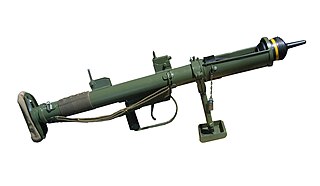
The Projector, Infantry, Anti Tank (PIAT) Mk I was a British man-portable anti-tank weapon developed during the Second World War. The PIAT was designed in 1942 in response to the British Army's need for a more effective infantry anti-tank weapon and entered service in 1943.

High-explosive anti-tank (HEAT) is a type of shaped charge explosive that uses the Munroe effect to penetrate heavy armor. The warhead functions by having an explosive charge collapse a metal liner inside the warhead into a high-velocity superplastic jet; this is capable of penetrating armor steel to a depth of seven or more times the diameter of the charge. The jet's effect is purely kinetic in nature; the round has no explosive or incendiary effect on the target.

R4M, abbreviation for Rakete, 4 kilogramm, Minenkopf, also known by the nickname Orkan due to its distinctive smoke trail when fired, was a folding-fin air-to-air rocket used by the Luftwaffe at the end of World War II.

An anti-tank mine is a type of land mine designed to damage or destroy vehicles including tanks and armored fighting vehicles.
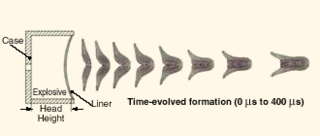
An explosively formed penetrator (EFP), also known as an explosively formed projectile, a self-forging warhead, or a self-forging fragment, is a special type of shaped charge designed to penetrate armor effectively. As the name suggests, the effect of the explosive charge is to deform a metal plate into a slug or rod shape and accelerate it toward a target. They were first developed as oil well perforators by American oil companies in the 1930s, and were deployed as weapons in World War II.

The Tellermine 43 was a German circular steel cased anti-tank blast mine used during the Second World War. It was a simplified version of the Tellermine 42, which enabled simpler production techniques. Between March 1943 and the end of World War II, over 3.6 million Tellermine 43s were produced by Germany. Copies of the mine were produced by several countries including Denmark (M/47), France and Yugoslavia (TMM-1).
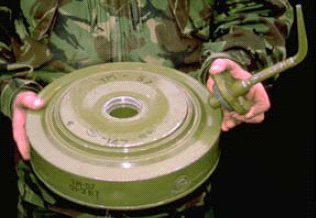
The TM-57 mine is a large, circular Soviet metal-cased blast anti-tank mine. It can either be triggered by a pressure or a tilt-rod fuze. A development of the TM-46 mine, it is found in Africa, the Middle East, and South East Asia.

The TM-46 mine is a large, circular, metal-cased Soviet anti-tank mine. It uses either a pressure or tilt-rod fuze, which is screwed into the top. Anti-tank mines with this type of fuze were capable of inflicting much more damage to armored vehicles, when compared to a typical AP mine.
The Hohl-Sprung Mine 4672 or Hohlladungs-Spring-Mine 4672 was a German anti-tank mine, together with the Panzer stab 43. Developed during the Second World War it was the first landmine to combine a shaped charge anti-tank warhead with a tilt rod fuze.
The M21 is a circular United States anti-tank landmine that uses a Misznay Schardin effect warhead. The mine uses an M607 pressure fuse, which can be adapted as a tilt rod fuze. The mine is triggered either by pressure, or by the tilt rod being forced beyond 20 degrees from the vertical by a force of more than 1.7 kg, either of these actions results in pressure being transferred via a bearing cap to a Belleville spring, which inverts, driving the firing pin into the M46 detonator. The M46 charge first ignites a black powder charge, which blows off the mine's cover, and clears any earth or debris that may have been on top of the mine. A fraction of a second later the main warhead detonates, driving and compressing a steel plate upwards, with enough force to penetrate 76 mm of armour at a distance of 530 mm. Approximately 200,000 M21 mines were produced in the U.S. and licensed copies, the K441 and K442, were produced in South Korea.
The MC-71 is a Romanian tilt-rod fuzed anti-tank landmine. The mine's body consists of two truncated cones, the lower of the cones contains the main charge and fuzing mechanism. The main charge is a large shaped charge, which triggers 200 ms to 400 ms after the tilt rod is activated. The tilt rod can be deployed away from the mine, potentially making it effective against clearance vehicles using mine rollers and mine flails.
The PT Mi-U is a circular Czech anti-tank mine with a Misznay Schardin effect warhead. It can be used with a conventional pressure fuze or a tilt rod fuze.
The PT Mi-P is a large Czechoslovakian anti-tank mine. The mine is a large hemisphere, with a carrying handle and an RO-9 attachment for a tilt rod on one side. It uses a large shaped charge warhead that uses a five millimeter thick steel liner, and can penetrate up to 150 millimeters of armour. The mine was in service with the armies of the Czech Republic and Slovakia, but is now obsolete.
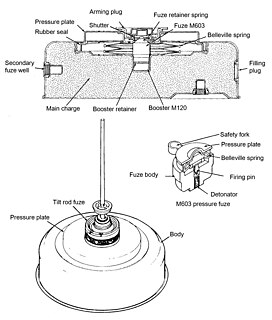
A tilt-rod fuze is a device used to trigger anti-vehicle landmines. Typically it consists of a vertical pole, normally around a meter high, which is connected to the top of a landmine. When the track or main body of a vehicle passes over the mine, the rod is tilted, releasing a spring-loaded striker which triggers a pyrotechnic delay of approximately half a second, followed by detonation of the main explosive charge. The small time delay allows the vehicle to continue over the mine before detonating, exposing more of it to the blast. A tilt-rod fuze has a number of advantages over pressure fuzes—it acts across the entire width of a vehicle, rather than just its tracks or tires. This allows it to attack the vehicle's belly and potentially cause a catastrophic kill. Additionally, tilt rod fuzes tend to be resistant to blast overpressure clearing methods, which can trigger most pressure fuzes.
The TMK-2 is a Soviet steel cased anti-tank mine. It uses a tilt-rod fuze combined with a shaped charge to attack the belly of vehicles as they pass over the mine. It was originally designed in 1955, but is now obsolete. The mine consists of a case shaped like two truncated cones joined at the base. The MVK-2 tilt rod assembly is held to one side of the mine. The lower truncated cone contains the main charge, and dished metal charge liner.

The Stielgranate 41 was a German shaped charge, fin-stabilized shell, used with the 3.7 cm Pak 36 anti-tank gun to give it better anti-tank performance.

The AB 250-2(Abwurfbehälter) was a cluster bomb used by the Luftwaffe during World War II.
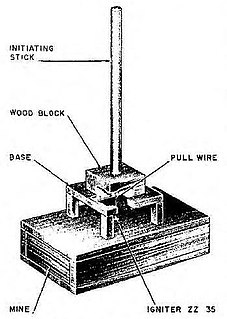
The B-Stabmine (Behelfs-Stabmine) or Makeshift Stickmine in English was an anti-tank mine that was developed by Germany and used by the Wehrmacht during World War II.













